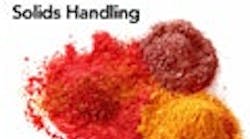Chemical Processing Powder eHandbook: Succeed at Solids Handling
Feb. 13, 2012
One of the trickiest materials to process, solids are comprised of powders or particulates, a continuous gaseous phase (usually air) and, almost always, a liquid component. Processors that handle solids know only too well the types of throughput problems that come up on a recurring basis. Clumping; effective, economical and safe slurry mixing; dust management and dust explosion risk mitigation are all very real challenges faced by processors of solids. In this Chemical Processing Powder eHandbook, we take a look at how to effectively handle solids including:
- Clumping – the 10 most common sources of agglomeration in bulk solids and how to effectively manage them
- Strategies for optimal slurry mixing
- Level management detection in storage vessels
- Dust explosion risks – how to identify and mitigate when processing solids
- Managing solid cohesiveness with flow strategies
Download your copy of this Chemical Processing Powder eHandbook now.
